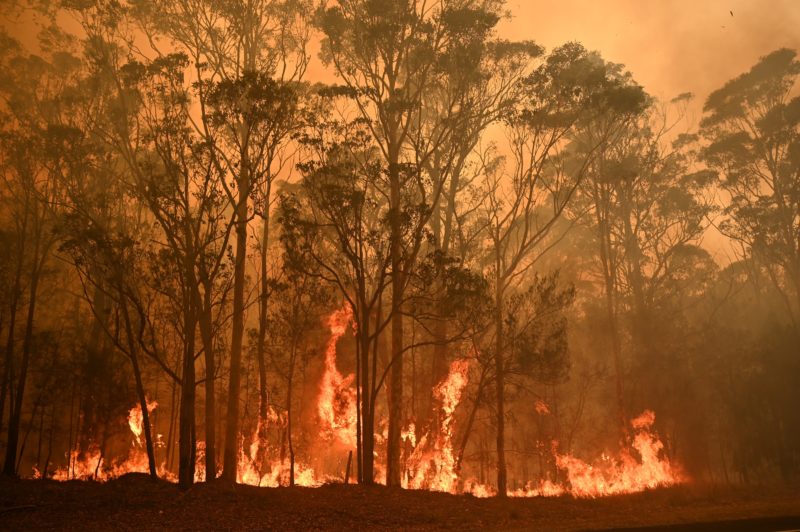Australia’s bushfire crisis turns off tourists
Australia’s bushfire crisis has hit tourism hard (PETER PARKS)
Mogo (Australia) (AFP) – Families grieving for lost homes and loved ones, burned koalas rescued from charred forests: The devastation of Australia’s bushfire crisis has tainted the country’s reputation as a safe and alluring holiday destination.
Images of the unprecedented scale of this summer’s blazes have evoked global shock and an outpouring of sympathy.
Thousands of tourists have been evacuated from coastal towns, international visitors have cancelled flights, and the US Department of State upgraded its security advice for Australia, warning travellers to “exercise increased caution”.
Tourism Australia was forced to suspend an upbeat advertising campaign featuring pop star Kylie Minogue that was launched in the middle of the crisis after the ad was met with incredulity about what many saw as poor timing.
“We’ve been selling Australia on clean air, clear skies, bright shiny beaches, hopping animals. Unfortunately, what people have been seeing (are) singed koalas and kangaroos,” said University of Technology Sydney lecturer David Beirman.
More than nine million overseas tourists visited Down Under in the 12 months to June 2019, adding almost Aus$45 billion ($31 billion) to the economy, while Australians holidaying across the vast continent country spent another Aus$100 billion.
Tourism Australia managing director Phillipa Harrison said it was “too early to quantify the full impact of the bushfires”.
But Beirman, who specialises in tourism risk and crisis management, estimates the losses have already run into “billions”, with the fires hitting during the peak summer holiday period and emptying whole regions of vacationers.
– Towns ‘deserted’ –
In tourism-reliant towns such as Mogo in New South Wales — where a bushfire reduced homes and businesses to twisted metal and ash — the impact has been felt immediately.
Ten days after the blaze roared through, most remaining shops were shuttered, unable to open until electricity was restored, while the handful that had re-opened were running on generators.
“It’s deserted,” gift shop owner Linda Pawley told AFP. “Usually there’s hundreds and thousands of people coming through each day.”
Pawley described herself as “one of the lucky ones” — her shop is still standing — but the future is uncertain.
“If the people don’t come back, a lot of the businesses will probably fade out,” she said. “I don’t know who’s going to keep their head above water and who’s not.”
Maureen Nathan, a retired pharmacist, spent 20 years building up a tourist attraction dedicated to Mogo’s 1850s gold rush — only for it to go up in flames on New Year’s Eve.
“That fire was hot enough to melt brass scales,” she said, telling AFP a pair of antique scales was found melted down to a small nugget in the rubble.
“That is the ferocity (of the fire) that came through at incredible speed in the little village of Mogo.”
The pain of losing more than a dozen buildings that contained irreplaceable historical artefacts was still too “raw” for her to be able to decide on the site’s future.
“And we’re not alone — it’s not one little pocket of a community, it’s the entire (region),” Nathan said. “It’s pretty well the entire eastern seaboard.”
– ‘Open for business’ –
As the bushfire threat has eased in recent days, Australian politicians have exhorted visitors to return to fire-ravaged areas and also not ignore destinations untouched by the disaster.
Tourism Minister Simon Birmingham emphasised the country was “still very much open for business”.
“There is much misinformation circulating online and in some media that exaggerates the geographical reach of these tragic bushfires,” he said in a statement to AFP.
“I urge people with a booking or considering travel to ensure they have the facts and don’t compound the harm to tourism operators by unnecessarily staying away.”
It is expected to take months or even years to rebuild Mogo and other devastated towns — raising fears some residents will leave to find employment elsewhere.
“It’s a critical issue because you don’t want to lose that workforce out of the tourist towns, and so there’s going to have to be some really strategic thinking and programmes in place to retain those people in communities,” Griffith Institute for Tourism director Sarah Gardiner told AFP.
But some are optimistic the country’s tourism industry can weather the crisis.
“Many countries have gone through natural disasters on the sort of scale we’re seeing with the Australian bushfires now and have bounced back pretty effectively — when they’ve got their strategies right,” tourism expert Beirman said, pointing to Japan’s recovery in the wake of the 2011 tsunami and nuclear disaster.
“I’m sure that people will come,” said Nathan from Mogo. “But please, just give us a few days’ breathing space. That’s all.”
Disclaimer: Validity of the above story is for 7 Days from original date of publishing. Source: AFP.


